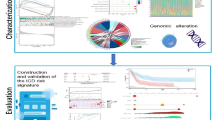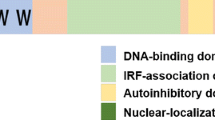Abstract
Interferon regulatory factor 4 (IRF4) is a member of the interferon regulatory family, which plays an important role in many lymphoid and myeloid malignancies. In the current study, using immunohistochemical staining, we found that IRF4 only expressed in plasma cells in bone marrow biopsy samples of multiple myeloma. IRF4-positive patients displayed increased disease stage (Durie–Salmon stage, p = 0.026; and International Staging System, p = 0.005). Silencing IRF4 in myeloma cell lines could inhibit myeloma cells proliferation and induce myeloma cell apoptosis, partly by JNK/Jun pathway. These results demonstrate that IRF4 plays important roles in myelomagenesis and disease progression.


Similar content being viewed by others
References
Yuregir OO, Sahin FI, Yilmaz Z, Kizilkilic E, Karakus S, Ozdogu H. Fluorescent in situ hybridization studies in multiple myeloma. Hematology. 2009;14:90–4.
Schmidt-Wolf IG, Glasmacher A, Hahn-Ast C, Juttner A, Schnurr T, Cremer F, et al. Chromosomal aberrations in 130 patients with multiple myeloma studied by interphase FISH: diagnostic and prognostic relevance. Cancer Genet Cytogenet. 2006;167:20–5.
Yoshida S, Nakazawa N, Iida S, Hayami Y, Sato S, Wakita A, et al. Detection of MUM1/IRF4-IgH fusion in multiple myeloma. Leukemia. 1999;13:1812–6.
Iida S, Rao PH, Butler M, Corradini P, Boccadoro M, Klein B, et al. Deregulation of MUM1/IRF4 by chromosomal translocation in multiple myeloma. Nat Genet. 1997;17:226–30.
Gualco G, Weiss LM, Bacchi CE. MUM1/IRF4: a review. Appl Immunohistochem Mol Morphol. 2010;18:301–10.
Yamamoto M, Kato T, Hotta C, Nishiyama A, Kurotaki D, Yoshinari M, et al. Shared and distinct functions of the transcription factors IRF4 and IRF8 in myeloid cell development. PLoS One. 2011;6:e25812.
Alizadeh AA, Eisen MB, Davis RE, Ma C, Lossos IS, Rosenwald A, et al. Distinct types of diffuse large B-cell lymphoma identified by gene expression profiling. Nature. 2000;403:503–11.
Pathak S, Ma S, Trinh L, Eudy J, Wagner KU, Joshi SS, et al. IRF4 is a suppressor of c-Myc induced B cell leukemia. PLoS One. 2011;6:e22628.
Havelange V, Pekarsky Y, Nakamura T, Palamarchuk A, Alder H, Rassenti L, et al. IRF4 mutations in chronic lymphocytic leukemia. Blood. 2011;118:2827–9.
Heintel D, Zojer N, Schreder M, Strasser-Weippl K, Kainz B, Vesely M, et al. Expression of MUM1/IRF4 mRNA as a prognostic marker in patients with multiple myeloma. Leukemia. 2008;22:441–5.
Shaffer AL, Emre NC, Lamy L, Ngo VN, Wright G, Xiao W, et al. IRF4 addiction in multiple myeloma. Nature. 2008;454:226–31.
Balakumaran A, Robey PG, Fedarko N, Landgren O. Bone marrow microenvironment in myelomagenesis: its potential role in early diagnosis. Expert Rev Mol Diagn. 2010;10:465–80.
Lemaire M, Deleu S, De Bruyne E, Van Valckenborgh E, Menu E, Vanderkerken K. The microenvironment and molecular biology of the multiple myeloma tumor. Adv Cancer Res. 2011;110:19–42.
Yaccoby S, Wezeman MJ, Henderson A, Cottler-Fox M, Yi Q, Barlogie B, et al. Cancer and the microenvironment: myeloma-osteoclast interactions as a model. Cancer Res. 2004;64:2016–23.
Colla S, Zhan F, Xiong W, Wu X, Xu H, Stephens O, et al. The oxidative stress response regulates DKK1 expression through the JNK signaling cascade in multiple myeloma plasma cells. Blood. 2007;109:4470–7.
Xu WD, Pan HF, Ye DQ, Xu Y. Targeting IRF4 in autoimmune diseases. Autoimmun Rev. 2012;11:918–24.
Kriegel AJ, Liu Y, Fang Y, Ding X, Liang M. The miR-29 family: genomics, cell biology, and relevance to renal and cardiovascular injury. Physiol Genomics. 2012;44:237–44.
Glasmacher E, Agrawal S, Chang AB, Murphy TL, Zeng W, Vander Lugt B, et al. A genomic regulatory element that directs assembly and function of immune-specific AP-1-IRF complexes. Science. 2012;338:975–80.
Podar K, Raab MS, Tonon G, Sattler M, Barila D, Zhang J, et al. Up-regulation of c-Jun inhibits proliferation and induces apoptosis via caspase-triggered c-Abl cleavage in human multiple myeloma. Cancer Res. 2007;67:1680–8.
Chen L, Wang S, Zhou Y, Wu X, Entin I, Epstein J, et al. Identification of early growth response protein 1 (EGR-1) as a novel target for JUN-induced apoptosis in multiple myeloma. Blood. 2010;115:61–70.
Acknowledgments
This work was supported by “Liu Da Ren Cai Gao Feng” of Jiangsu Province (2009); National Natural Science Foundation of China (81071946, 81241074); and Jiangsu Province’s Medical Elite Program (RC201148), and this project was supported by the Scientific Research Starting Foundation for Returned Overseas Chellonese Scholars, Ministry of Education (2012), and Foundation of Jiangsu Provincial Bureau of Health (H200932). The project was funded by the Priority Academic Program Development of Jiangsu Higher Education Institutions; the Program for Development of Innovative Research Team in the First Affiliated Hospital of NJMU; Clinical Research Program from Health Ministry of China (Key project 2010 to 2012); Scientific Research Program for Public Interests from the Health Ministry of China (No.201202017).
Conflict of interest
All authors have no conflict of interest to report.
Author information
Authors and Affiliations
Corresponding author
Rights and permissions
About this article
Cite this article
Zhang, S., Xu, J., Wu, S. et al. IRF4 promotes cell proliferation by JNK pathway in multiple myeloma. Med Oncol 30, 594 (2013). https://doi.org/10.1007/s12032-013-0594-8
Received:
Accepted:
Published:
DOI: https://doi.org/10.1007/s12032-013-0594-8




